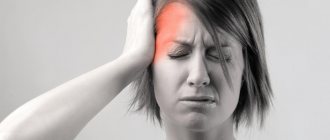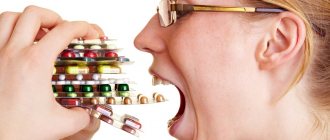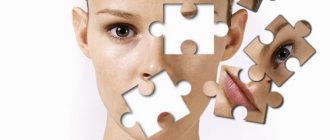In neurology, a pressing, dull headache with classic symptoms is called tension cephalgia (tension headache). The pain is dull, accompanied by a feeling of pressure, usually localized diffusely on both sides of the skull. Relatively often, during an attack, a person experiences pressure on his temples and feels dizzy. Why is this happening?
Why do spasms occur in the temples?
What hurts during a headache attack? The bones of the skull and brain tissue never hurt because they are not supplied with nerve fibers that carry pain. On the contrary, the nerve connections and nerves located between the skin and the cranial bones are painful. The muscles and blood vessels in the brain, as well as those that supply the tissues of the extracranial bones, can hurt.
Painful nerve endings are called nociceptors, and can be stimulated by stress, muscle tension, vasodilation and other provoking factors. The stimulated nociceptor sends a signal to nerve cells in the brain, telling it which part of the body is affected. For example, a person suddenly becomes aware of pain in his toe when the nociceptors in that area are stimulated.
Many chemicals help to convey pain information. Some of them are painkillers, called endorphins (from Greek: “morphine within”). One theory is that people who suffer from headaches have lower levels of endorphins than people who don't have headaches.
Why do you feel dizzy when you stand up?
Many people, when suddenly rising from a chair or bed, experience short-term attacks of dizziness, which in some cases are accompanied by a feeling of nausea, darkening of the eyes and tinnitus.
The duration of such attacks does not exceed five to seven seconds, and their frequency can be very different, from one attack per month to several attacks per day.
The cause of this phenomenon is considered to be orthostatic hypotension - a sharp drop in intra-arterial pressure, leading to a decrease in blood circulation in the brain, which in turn leads to dizziness and sometimes fainting. Here are some common symptoms present during attacks:
- Severe weakness;
- Blurry vision;
- Convulsions;
- Unpleasant sensations in the epigastric region;
Orthostatic hypotension occurs due to various problems with the cardiovascular system, atherosclerosis, diabetes, taking diuretics, drug or alcohol use, as well as pheochromocytoma.
Treatment of the disease is carried out after identifying its true cause. In all other cases, it is recommended to regularly walk in the fresh air, do exercises in the morning, change your diet and take various herbal tinctures.
In the presence of orthostatic hypotension, patients are advised not to make sudden ascents, but to smoothly move from a horizontal position to a semi-vertical position (sitting) and only after that, after a few minutes, get out of bed.
Tension pain - causes, symptoms
Frequent pain and throbbing can be caused by tension in the neck muscles, located in the area from the cervical spine throughout the entire head area, attached to the eyebrows and temples. Therefore, during muscle strain, the temples are pressed, and not the other part of the head.
Often the reason why temples hurt is the result of working on a computer, so when it occurs, it is important to stop working and do a massage to relax the muscles.
Important! If there is pressure on your temples and you feel dizzy due to prolonged viewing of the monitor, anti-inflammatory drugs based on Paracetamol will help.
This is not a life-threatening problem, but tension cephalgia is often combined with migraine attacks. In this case, it is said that there is a mixed headache; it is more complex and involves treatment of both diagnoses. It is easy to distinguish tension headaches from migraines: in the first case the pain is bilateral, in case of a migraine attack it is unilateral (the right temple or the left one hurts).
Most often, pain in the temples and dizziness occur in more sensitive, receptive, and tense people. The disease is often combined with anxiety, depression, and sleep disorders.
Traditional treatment for dizziness
Dizziness, nausea, pain in the temples are the eternal problems of humanity. People encountered them hundreds and thousands of years ago. Therefore, over such a long period of time, many different methods were invented, passed on from generation to generation and eliminating these unpleasant manifestations. Here are the most common and effective ones:
- Once a day you should eat a small spoon of kelp ground into powder.
- If you feel slightly dizzy, you can inhale the smell of a fresh onion; to enhance the effect, you can cut it in half.
- A sweetened sage infusion is excellent for dizziness. To prepare it, you need to pour a few large spoons of the herb into boiling water, cook for about five minutes and let it brew for about an hour.
- You can cut an onion in half and rub it on your temples. Such procedures help with both headaches and dizziness.
- Veronica herb is no less effective. It is brewed similarly to tea and infused for about an hour.
- A hot shower is very effective for headaches, since after it the blood vessels dilate and the blood pressure on them decreases.
- You can also use heated kitchen salt to relieve headaches. To do this, you need to take half a kilogram of salt and heat it on a baking sheet or cast iron frying pan, place it on a cotton cloth and wrap it in a sock (it needs to be tied well). The resulting product must be applied to the back of the head for 15-20 minutes.
All these remedies are effective in cases where the cause of dizziness and headache is not a consequence of any disease. In other cases, the symptoms can be eliminated only by defeating the disease that provokes their appearance.
Nature of spasms and additional symptoms
Symptoms include a dull ache and sometimes increased tension in the head and neck. Soreness – pressing or squeezing, usually without other symptoms.
The onset of the disease is gradual, the intensity of symptoms may fluctuate slightly. As a rule, there is a feeling of pressure, as if the head is being squeezed, for example, by a tight headdress. The pain is bilateral, sometimes felt all over the head.
The intensity of the attack does not increase with physical activity and rarely forces a person to lie down. Unlike migraines, they are not accompanied by nausea or vomiting, but slight weakness may occur.
Medicines for dizziness
An excellent drug is “Angiosil retard”, it is prescribed for instability, dizziness, tinnitus, vestibular dysfunction, as well as for chronic coronary heart disease. Betaserc is very effective; it additionally relieves headaches and nausea. It is prescribed to patients with Meniere's disease.
The excellent Croatian drug Dramina has similar properties. If dizziness and headache are of a viral nature, then use “Golden Star Balm”. It helps with bites of various non-venomous insects, influenza, acute non-zopharyngitis, and upper respiratory tract infections. There are many analogues of these drugs, so you can consult with pharmacists and your doctor if you have allergic reactions or if the medicine is not available in pharmacies.
But it is worth remembering that self-medication can lead to a worsening of the disease, and the symptoms become blurred, and therefore it becomes much more difficult to identify and cure the disease. Therefore, seek help from a doctor!
External and internal factors that provoke spasms in the temples
The cause of a headache is not easy to determine. Soreness as such is only a symptom, that is, a manifestation of the underlying disorder. One type of cephalalgia in different conditions, time frames, situations can have several different causes. In the occurrence of the most common headache, tension headache, the psyche plays a significant role (internal tension, fatigue, anxiety, leading to increased tension in the neck muscles).
The causative factor may be:
- stress;
- lack or prolonged absence of sleep;
- uncomfortable position while working;
- poor posture;
- irregular eating (or hunger);
- eye strain.
External factors:
- intoxication – in particular, carbon monoxide poisoning;
- prolonged hunger (more than a day);
- staying at altitude (above 3 km) – compresses the temples due to lack of oxygen;
- airplane flights – the cause of pain in the temples and dizziness is an increase in intracranial pressure.
Diagnostic methods
The occurrence of a headache in the temples, especially when it is accompanied by nausea, is a symptom that should never be ignored.
You can stop an attack with pills once, but if this alarming symptom recurs, you should not delay your visit to the doctor.
For diagnosis, specialists use the following methods:
- A blood test that will help determine if there is an infection in the body.
- Spinal tap. It is prescribed if the patient is suspected of having intracranial hemorrhage or meningitis.
- CT or MRI examination. These diagnostic methods make it possible to detect the presence of brain tumors even at an early stage and thoroughly examine all its areas.
Depending on the diagnosis, the doctor prescribes further treatment.
Pain prevention
To prevent pressure and pain in the temples and dizziness, you can try the following measures:
- reducing emotional and physical stress - deep breathing, meditation, muscle relaxation;
- relaxation of the head, neck, shoulders;
- exercise several times a week (be careful not to overdo it - too much exercise can cause pain, pressure in the temples, and increase dizziness);
- sufficient sleep;
- nicotine cessation;
- regular healthy eating;
- adherence to a rest schedule - a regimen can help reduce the number of stressful situations that cause dizziness, soreness and pressure in the temples;
- limiting caffeine – although some medications contain caffeine, consuming it in the form of drinks (coffee, chocolate, Coca-Cola) may cause discomfort;
- taking medication in accordance with medical recommendations.
Do not underestimate blood pressure, pain in the temples, dizziness, and seek specialized help if unusual symptoms appear. An examination is necessary if discomfort occurs more than once a week or lasts longer than a day.
Spot impact
Massage is a time-tested remedy for muscle pain and headaches. Quite often, headache syndrome occurs in people whose professional activities are directly related to prolonged stay in one position (sitting, standing). In such cases, the muscles often pinch the arteries that supply the brain with blood, resulting in a headache. To remove it, just perform acupressure. Here's what you need to do:
- For throbbing or squeezing pain in the temples, it is recommended to massage them. The massage is carried out in a circular motion; there is no need to press hard. It is best to carry out the procedure in a horizontal position.
- To relieve headaches, you need to massage your forehead in the middle, focusing on the line of the bridge of your nose. Movements should also be light and relaxed.
- Two active points are located right on the eyebrows, at the very end, near the bridge of the nose. You need to feel small depressions on both sides and make thirty circular movements in one direction and the other.
- Two more active points are located right next to the ear. To find them, you need to place your index fingers on the edges of your eyes and draw straight lines to your ears.
- Massaging the back of the head also relieves headaches.
- Additionally, it is recommended to massage the shoulders, but it is better if it is performed by someone close to you.
It is best if the massage is performed by a relative or friend; it is difficult to relieve muscle tension on your own. You can also seek the help of a professional massage therapist.
Migraine and cluster headaches
Migraine is characterized by intense headache, localized predominantly on one side. Unpleasant sensations can spread to the area of the upper jaw, back of the head, forehead and temples, manifested by pressing, pulsating, bursting pain, often causing additional pain in the eyes. Exposure to external stimuli (bright light, loud sounds) increases pain, and the attack is often complicated by nausea, vomiting, dizziness, and general weakness.
Cluster cephalgia is characterized by a series of attacks of intense pain several times a day. The attack begins with severe pain in the eye socket and ear, spreading to the forehead, temples and behind the eyes, and the headache is so severe that there is evidence of cases of suicide in order to stop the torment.
Treatment and diagnosis of pressing pain in the temples
To completely get rid of cephalgia, it is imperative to identify the cause of the attacks. To do this, the neurologist conducts a detailed survey of the patient, finds out the intensity of the pain, provoking factors, the duration of the attacks and the time of their occurrence. If necessary, the patient is sent for computed tomography or magnetic resonance imaging, angiography to assess the condition of the brain and its vessels. In some cases, a consultation with an ophthalmologist is required to diagnose the eye condition.
To determine the cause of the headache, you must visit a doctor
Until the exact cause of the pain is clarified, you can take a painkiller from the group of non-steroidal anti-inflammatory drugs - Nise, Nurofen, Paracetamol. A light massage of the temples with your fingertips, a short nap, or just relaxing in a quiet room will help ease the pain a little.
The frequency of attacks can be reduced if you follow simple rules of prevention - walking in the fresh air, exercise and good nutrition have a positive effect. When working sedentarily, it is recommended to do a light warm-up several times a day.










